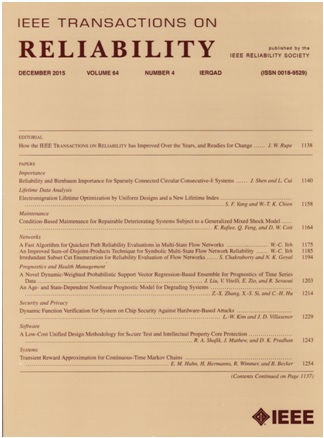Integrated Temperature and Stress Sensors in Fan-Out Wafer-Level Packaging to Better Achieve the Third-Generation Reliability of Electronic Systems
IF 5.7
2区 计算机科学
Q1 COMPUTER SCIENCE, HARDWARE & ARCHITECTURE
引用次数: 0
Abstract
To satisfy the developmental requirements of applications, such as autonomous driving, high-performance computing, and the Internet of Things (IoT), the integration density, performance, and reliability tradeoff of electronic systems are posing numerous challenges. Prognostics and health management (PHM) using multiple types of sensors can address reliability problems and enhance the functional safety of electronic systems. However, the limited integration density of conventional electronic packaging indicates that functional chips can only replace sensor chips for physical quantity monitoring, without simultaneous functional degradation monitoring and fault identification. This study proposed an integration method that is compatible with front and rear processes to integrate temperature and stress sensors into the power-driven module, that is, fan-out wafer-level packaging technology. First, the temperature and stress sensors are calibrated using a microloading platform and sensitivity consistency is ensured. Second, the temperature inside the module under various working conditions is evaluated using the data obtained by temperature sensors. The stress data inside the micromodule under mechanical loading are obtained through stress sensors. The proposed method can realize在扇出晶圆级封装中集成温度和应力传感器,以更好地实现电子系统的第三代可靠性
为了满足自动驾驶、高性能计算和物联网(IoT)等应用的发展需求,电子系统的集成密度、性能和可靠性权衡提出了许多挑战。使用多种类型传感器的预测和健康管理(PHM)可以解决可靠性问题并提高电子系统的功能安全性。然而,传统电子封装的集成度有限,功能芯片只能替代传感器芯片进行物理量监测,无法同时进行功能退化监测和故障识别。本研究提出了一种前后工艺兼容的集成方法,将温度和应力传感器集成到功率驱动模块中,即扇出式晶圆级封装技术。首先,利用微加载平台对温度和应力传感器进行了标定,保证了灵敏度的一致性。其次,利用温度传感器获得的数据,评估各种工况下模块内部的温度。通过应力传感器获得微模块内部在机械载荷作用下的应力数据。该方法可实现先进封装内部的现场监测,为PHM研究提供了可观的数据。
本文章由计算机程序翻译,如有差异,请以英文原文为准。
求助全文
约1分钟内获得全文
求助全文
来源期刊

IEEE Transactions on Reliability
工程技术-工程:电子与电气
CiteScore
12.20
自引率
8.50%
发文量
153
审稿时长
7.5 months
期刊介绍:
IEEE Transactions on Reliability is a refereed journal for the reliability and allied disciplines including, but not limited to, maintainability, physics of failure, life testing, prognostics, design and manufacture for reliability, reliability for systems of systems, network availability, mission success, warranty, safety, and various measures of effectiveness. Topics eligible for publication range from hardware to software, from materials to systems, from consumer and industrial devices to manufacturing plants, from individual items to networks, from techniques for making things better to ways of predicting and measuring behavior in the field. As an engineering subject that supports new and existing technologies, we constantly expand into new areas of the assurance sciences.
 求助内容:
求助内容: 应助结果提醒方式:
应助结果提醒方式:


